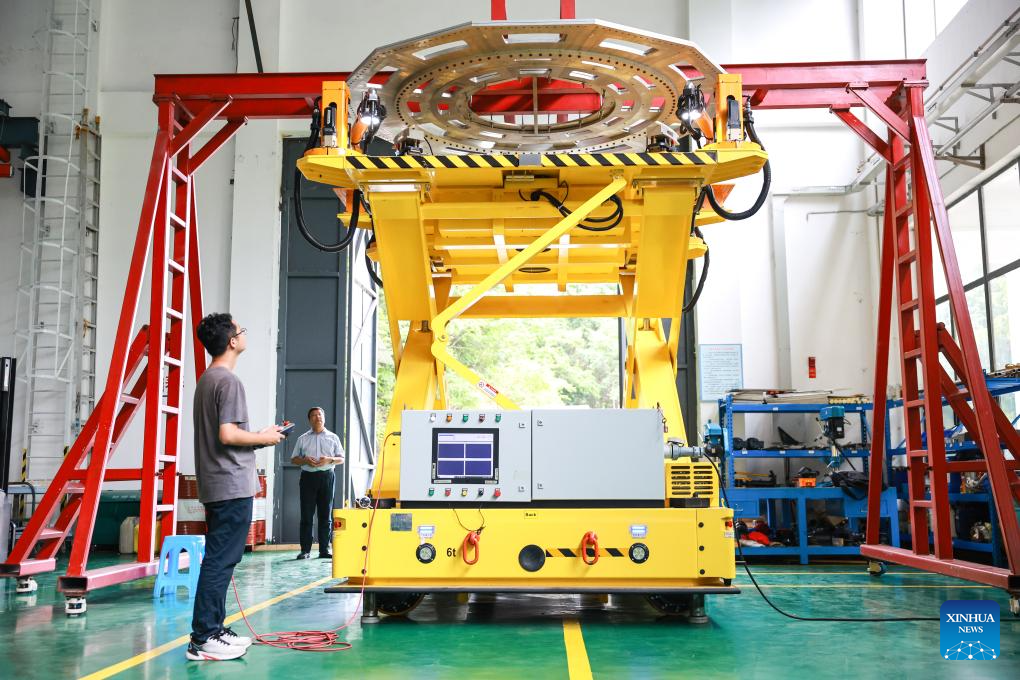
Staff members adjust a maintenance robot designed for China's Five-hundred-meter Aperture Spherical Radio Telescope (FAST) in southwest China's Guizhou Province, on July 26, 2023. A robotic system project for operation and maintenance of the FAST passed on-site appraisal Wednesday. It was one of the key projects designated by state authorities in research and development of smart robots.
FAST, the world's largest single-dish radio telescope, has identified over 800 new pulsars since its launch in 2016, its operator said Tuesday.
Dubbed the "China Sky Eye," the telescope is located in a naturally deep and round karst depression in the southwestern province of Guizhou. It has a reception area equal to 30 standard football fields. (Xinhua/Ou Dongqu)
GUIYANG, July 27 (Xinhua) -- Five intelligent robot systems and platforms for the maintenance of China's Five-hundred-meter Aperture Spherical Radio Telescope (FAST), the world's largest single-dish radio telescope, have passed inspection and can be put into use, local authorities said on Wednesday.
The intelligent robots will be mainly used in testing of the supporting cables and pulleys of FAST's feed, the automatic maintenance of its actuators and laser targets on the reflector, the disassembling and installation of feed receivers, the monitoring of radio interference, and the all-weather measurement of its 30-tonne feed cabin.
According to Jiang Peng, FAST's chief engineer, the intelligent robots will help safeguard the telescope's operation, increasing its observation duration and efficiency while promoting more scientific results.
"The intelligent robots are expected to add about 30 days to the telescope's observation period annually," said Jiang.
Dubbed the "China Sky Eye," the telescope is located in a naturally deep and round karst depression in the southwestern province of Guizhou. It has a reception area equal to 30 standard football fields. ■

A staff member adjusts a maintenance robot designed for China's Five-hundred-meter Aperture Spherical Radio Telescope (FAST) in southwest China's Guizhou Province, on July 25, 2023. A robotic system project for operation and maintenance of the FAST passed on-site appraisal Wednesday. It was one of the key projects designated by state authorities in research and development of smart robots.
FAST, the world's largest single-dish radio telescope, has identified over 800 new pulsars since its launch in 2016, its operator said Tuesday.
Dubbed the "China Sky Eye," the telescope is located in a naturally deep and round karst depression in the southwestern province of Guizhou. It has a reception area equal to 30 standard football fields. (Xinhua/Ou Dongqu)

A staff member checks a maintenance robot designed for China's Five-hundred-meter Aperture Spherical Radio Telescope (FAST) in southwest China's Guizhou Province, on July 26, 2023. A robotic system project for operation and maintenance of the FAST passed on-site appraisal Wednesday. It was one of the key projects designated by state authorities in research and development of smart robots.
FAST, the world's largest single-dish radio telescope, has identified over 800 new pulsars since its launch in 2016, its operator said Tuesday.
Dubbed the "China Sky Eye," the telescope is located in a naturally deep and round karst depression in the southwestern province of Guizhou. It has a reception area equal to 30 standard football fields. (Xinhua/Ou Dongqu)

A staff member adjusts a maintenance robot designed for China's Five-hundred-meter Aperture Spherical Radio Telescope (FAST) in southwest China's Guizhou Province, on July 26, 2023. A robotic system project for operation and maintenance of the FAST passed on-site appraisal Wednesday. It was one of the key projects designated by state authorities in research and development of smart robots.
FAST, the world's largest single-dish radio telescope, has identified over 800 new pulsars since its launch in 2016, its operator said Tuesday.
Dubbed the "China Sky Eye," the telescope is located in a naturally deep and round karst depression in the southwestern province of Guizhou. It has a reception area equal to 30 standard football fields. (Xinhua/Ou Dongqu)

A staff member adjusts a maintenance robot platform system designed for China's Five-hundred-meter Aperture Spherical Radio Telescope (FAST) in southwest China's Guizhou Province, on July 25, 2023. A robotic system project for operation and maintenance of the FAST passed on-site appraisal Wednesday. It was one of the key projects designated by state authorities in research and development of smart robots.
FAST, the world's largest single-dish radio telescope, has identified over 800 new pulsars since its launch in 2016, its operator said Tuesday.
Dubbed the "China Sky Eye," the telescope is located in a naturally deep and round karst depression in the southwestern province of Guizhou. It has a reception area equal to 30 standard football fields. (Xinhua/Ou Dongqu)

A staff member adjusts a maintenance robot designed for China's Five-hundred-meter Aperture Spherical Radio Telescope (FAST) in southwest China's Guizhou Province, on July 25, 2023. A robotic system project for operation and maintenance of the FAST passed on-site appraisal Wednesday. It was one of the key projects designated by state authorities in research and development of smart robots.
FAST, the world's largest single-dish radio telescope, has identified over 800 new pulsars since its launch in 2016, its operator said Tuesday.
Dubbed the "China Sky Eye," the telescope is located in a naturally deep and round karst depression in the southwestern province of Guizhou. It has a reception area equal to 30 standard football fields. (Xinhua/Ou Dongqu)

A staff member is pictured under the feed cabin of the Five-hundred-meter Aperture Spherical Radio Telescope (FAST) in southwest China's Guizhou Province on July 26, 2023. A robotic system project for operation and maintenance of the FAST passed on-site appraisal Wednesday. It was one of the key projects designated by state authorities in research and development of smart robots.
FAST, the world's largest single-dish radio telescope, has identified over 800 new pulsars since its launch in 2016, its operator said Tuesday.
Dubbed the "China Sky Eye," the telescope is located in a naturally deep and round karst depression in the southwestern province of Guizhou. It has a reception area equal to 30 standard football fields. (Xinhua/Ou Dongqu)

This photo taken on July 26, 2023 shows the feed cabin of China's Five-hundred-meter Aperture Spherical Radio Telescope (FAST) under maintenance in southwest China's Guizhou Province. A robotic system project for operation and maintenance of the FAST passed on-site appraisal Wednesday. It was one of the key projects designated by state authorities in research and development of smart robots.
FAST, the world's largest single-dish radio telescope, has identified over 800 new pulsars since its launch in 2016, its operator said Tuesday.
Dubbed the "China Sky Eye," the telescope is located in a naturally deep and round karst depression in the southwestern province of Guizhou. It has a reception area equal to 30 standard football fields. (Xinhua/Ou Dongqu)

This aerial photo taken on July 26, 2023 shows China's Five-hundred-meter Aperture Spherical Radio Telescope (FAST) in southwest China's Guizhou Province. A robotic system project for operation and maintenance of the FAST passed on-site appraisal Wednesday. It was one of the key projects designated by state authorities in research and development of smart robots.
FAST, the world's largest single-dish radio telescope, has identified over 800 new pulsars since its launch in 2016, its operator said Tuesday.
Dubbed the "China Sky Eye," the telescope is located in a naturally deep and round karst depression in the southwestern province of Guizhou. It has a reception area equal to 30 standard football fields. (Xinhua/Ou Dongqu)

This aerial panoramic photo taken on July 26, 2023 shows China's Five-hundred-meter Aperture Spherical Radio Telescope (FAST) in southwest China's Guizhou Province. A robotic system project for operation and maintenance of the FAST passed on-site appraisal Wednesday. It was one of the key projects designated by state authorities in research and development of smart robots.
FAST, the world's largest single-dish radio telescope, has identified over 800 new pulsars since its launch in 2016, its operator said Tuesday.
Dubbed the "China Sky Eye," the telescope is located in a naturally deep and round karst depression in the southwestern province of Guizhou. It has a reception area equal to 30 standard football fields. (Xinhua/Ou Dongqu)

This aerial panoramic photo taken on July 26, 2023 shows China's Five-hundred-meter Aperture Spherical Radio Telescope (FAST) in southwest China's Guizhou Province. A robotic system project for operation and maintenance of the FAST passed on-site appraisal Wednesday. It was one of the key projects designated by state authorities in research and development of smart robots.
FAST, the world's largest single-dish radio telescope, has identified over 800 new pulsars since its launch in 2016, its operator said Tuesday.
Dubbed the "China Sky Eye," the telescope is located in a naturally deep and round karst depression in the southwestern province of Guizhou. It has a reception area equal to 30 standard football fields. (Xinhua/Ou Dongqu)

This aerial panoramic photo taken on July 26, 2023 shows China's Five-hundred-meter Aperture Spherical Radio Telescope (FAST) in southwest China's Guizhou Province. A robotic system project for operation and maintenance of the FAST passed on-site appraisal Wednesday. It was one of the key projects designated by state authorities in research and development of smart robots.
FAST, the world's largest single-dish radio telescope, has identified over 800 new pulsars since its launch in 2016, its operator said Tuesday.
Dubbed the "China Sky Eye," the telescope is located in a naturally deep and round karst depression in the southwestern province of Guizhou. It has a reception area equal to 30 standard football fields. (Xinhua/Ou Dongqu)

This aerial panoramic photo taken on July 26, 2023 shows China's Five-hundred-meter Aperture Spherical Radio Telescope (FAST) in southwest China's Guizhou Province. A robotic system project for operation and maintenance of the FAST passed on-site appraisal Wednesday. It was one of the key projects designated by state authorities in research and development of smart robots.
FAST, the world's largest single-dish radio telescope, has identified over 800 new pulsars since its launch in 2016, its operator said Tuesday.
Dubbed the "China Sky Eye," the telescope is located in a naturally deep and round karst depression in the southwestern province of Guizhou. It has a reception area equal to 30 standard football fields. (Xinhua/Ou Dongqu)

This aerial panoramic photo taken on July 26, 2023 shows China's Five-hundred-meter Aperture Spherical Radio Telescope (FAST) in southwest China's Guizhou Province. A robotic system project for operation and maintenance of the FAST passed on-site appraisal Wednesday. It was one of the key projects designated by state authorities in research and development of smart robots.
FAST, the world's largest single-dish radio telescope, has identified over 800 new pulsars since its launch in 2016, its operator said Tuesday.
Dubbed the "China Sky Eye," the telescope is located in a naturally deep and round karst depression in the southwestern province of Guizhou. It has a reception area equal to 30 standard football fields. (Xinhua/Ou Dongqu)



